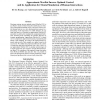Free Online Productivity Tools
i2Speak
i2Symbol
i2OCR
iTex2Img
iWeb2Print
iWeb2Shot
i2Type
iPdf2Split
iPdf2Merge
i2Bopomofo
i2Arabic
i2Style
i2Image
i2PDF
iLatex2Rtf
Sci2ools
AAAI
2015
2015
Approximate MaxEnt Inverse Optimal Control and Its Application for Mental Simulation of Human Interactions
Maximum entropy inverse optimal control (MaxEnt IOC) is an effective means of discovering the underlying cost function of demonstrated human activity and can be used to predict human behavior over low-dimensional state spaces (i.e., forecasting of 2D trajectories). To enable inference in very large state spaces, we introduce an approximate MaxEnt IOC procedure to address the fundamental computational bottleneck stemming from calculating the partition function via dynamic programming. Approximate MaxEnt IOC is based on two components: approximate dynamic programming and Monte Carlo sampling. We analyze this approximation approach and provide a finite-sample error upper bound on its excess loss. We validate the proposed method in the context of analyzing dual-agent interactions from video, where we use approximate MaxEnt IOC to simulate mental images of a single agents body pose sequence (a high-dimensional image space). We experiment with sequences image data taken from RGB and RGBD d...
| Added | 27 Mar 2016 |
| Updated | 27 Mar 2016 |
| Type | Journal |
| Year | 2015 |
| Where | AAAI |
| Authors | De-An Huang, Amir Massoud Farahmand, Kris M. Kitani, James Andrew Bagnell |
Comments (0)

